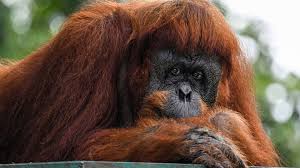Orangutan Diplomacy:

Malaysia has initiated “Orangutan Diplomacy” to address sustainability concerns related to palm oil-linked deforestation affecting orangutans, in response to backlash.
- Orangutans widely recognized for their distinctive red fur, are considered to be the largest tree-dwelling mammals.
- They are primarily arboreal, spending over 90% of their waking hours in trees.
- Orangutans are highly intelligent and share 4% of their genes with humans, making their conservation even more significant.
- They inhabit the Indonesian island of Sumatra and the Malaysian and Indonesian parts of Borneo.
- Their habitat spans from lowland peat swamp forests to high-altitude mountainous forests, reaching nearly 6 kilometres above sea level
- There are three species of orangutans: Bornean, Sumatran, and Tapanuli.
- Adult males are generally about twice the size of females, standing up to 3 meters tall and weighing up to 130 kg in the wild.
- They are covered in long, sparse orange or reddish hair. They possess arms significantly longer than their legs and have grasping hands and feet with long, curved fingers and toes. Mature males develop prominent cheek pads, a unique feature among primates.
- Lifespan: Orangutans can live up to 50 years in the wild
- They are primarily daytime feeders with a diet mainly consisting of fruit and leaves such as lychees and figs. They also consume nuts, bark, insects, and occasionally bird eggs.
- Orangutans are known for their semi-solitary behaviour.
- Though they are the most solitary among great apes, they do show social tolerance during periods of high fruit availability, coming together in groups known as parties.
- All three species of orangutans are listed as ‘Critically Endangered’ on the IUCN Red List.




